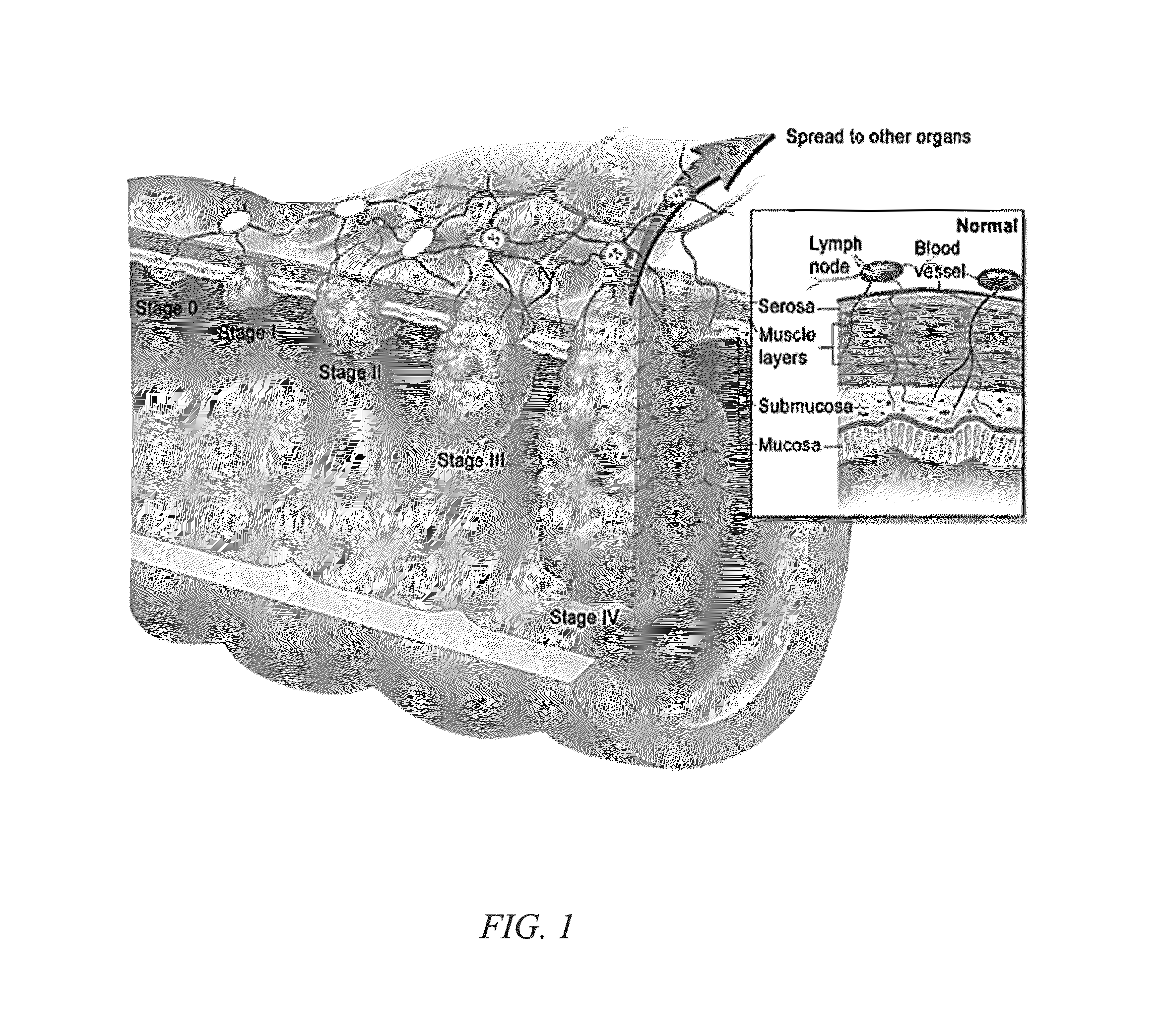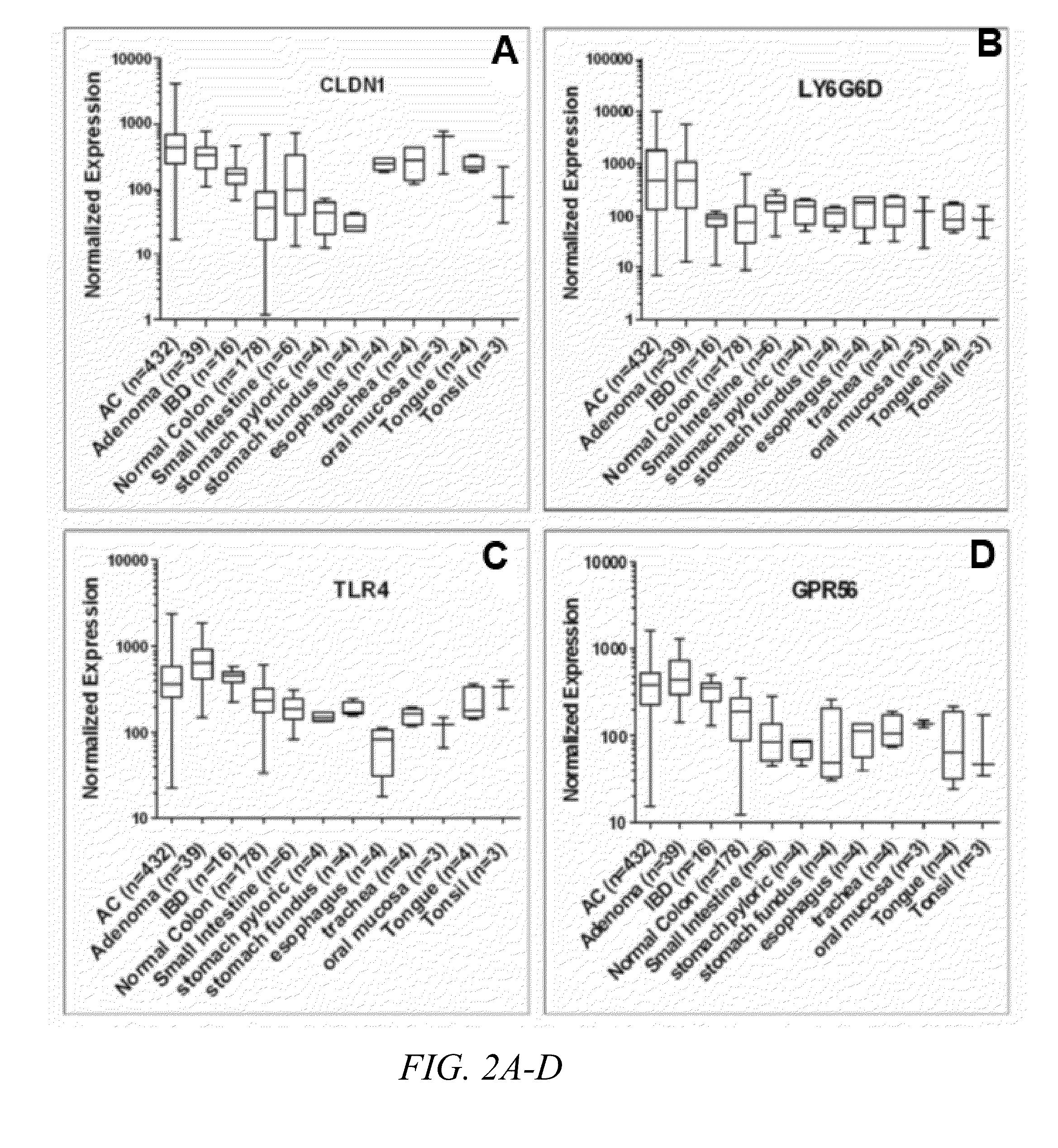Method of screening for colon cancer using biomarkers
a biomarker and colon cancer technology, applied in the field of colon cancer detection and diagnosis, can solve the problems of low patient compliance of colonoscopy, low specificity of colonoscopy detection, and low cost of vc procedures, so as to improve the specificity and sensitivity of detection.
- Summary
- Abstract
- Description
- Claims
- Application Information
AI Technical Summary
Benefits of technology
Problems solved by technology
Method used
Image
Examples
example 1
Identification of Gene Markers
[0073]Through gene expression profiling of DNA microarray data from patient tissue samples of colon adenomas, adenocarcinomas, inflammatory bowel disease and unaffected tissues throughout the GI tract, the inventors have identified six putative cell surface proteins (CLDN1, GPR56. GRM8, LY6G6D, TLR4 and SLCO1B3) that are highly expressed in colon adenomas and adenocarcinomas but not in unaffected tissues. Two combinations of three markers (CLDN1, LY6G6D and TLR4, or CLDN1, GPR56 and TLR4) had 100% coverage of the 689 CRC samples in the microarrays, where at least one of the three markers is overexpressed in every sample.
[0074]Immunohistochemistry (IHC) was performed to confirm protein expression of these markers in patient samples of CRC and unaffected colon tissue. All of these markers demonstrated high expression in adenomas and adenocarcinomas. High expression was also observed in a fraction of the normal tissues, but the staining was more diffuse du...
example 2
Development of MRI and CT Contrast Agents
[0104]Patients may be screened for colon cancer with either CT- or MR-based molecular colonography (virtual colonoscopy, VC) using targeted oral contrast reagents that specifically bind to and identify pre-cancerous lesions with high conspicuity. This oral reagent is a cocktail mixture of individual agents, each identifying a phenotypic subset of pre-cancerous and cancerous lesions. The first marker used to develop MRI and CT contrast agents (CA) targeted against it is TLR4, which is highly expressed in ˜50% of human CRC. In parallel, ligands for additional targets are developed. The agents are comprised of biocompatible and biostable CA that are decorated with multiple copies of the TLR4 specific synthetic ligand. The CA must be biocompatible and be capable of being imaged by either CT or MRI in the GI tract. Additionally, the CA and ligand must be stable in the digestive tract and achieve selectivity using multivalent (effectively irreversi...
example 3
Development of CRC-Targeted Molecular Imaging Probes Using TLR4-Specific Ligands
[0132]High-affinity binding ligands are available for Toll-like receptor 4 (TLR4), including the synthetic lipid A derivative, Eritoran; an irreversible inhibitor, TAK 242; and β-amino alcohol-type inhibitors. These ligands are individually evaluated for binding activity and selectivity using TLR4-expressing HT-29 cells and non-expressing tumor cell lines and the existing in cyto binding assay. The ligand with the highest affinity and specificity for TLR4 is tested for biostability at 37° C. and low pH. The ligand may also be tested in serum prior to attachment to existing MRI and CT contrast agents to form highly selective multivalent binding constructs. A gold nanoparticle formulation and a sucrose-based scaffold carrying multiple DOTA-Gd(III) chelates is used for in vivo μCT and MRI in mice. Agonist / antagonist activity of the targeted contrast agents is determined using a bioassay for NF-κB signaling ...
PUM
| Property | Measurement | Unit |
|---|---|---|
| Time | aaaaa | aaaaa |
| Level | aaaaa | aaaaa |
Abstract
Description
Claims
Application Information
 Login to View More
Login to View More - R&D
- Intellectual Property
- Life Sciences
- Materials
- Tech Scout
- Unparalleled Data Quality
- Higher Quality Content
- 60% Fewer Hallucinations
Browse by: Latest US Patents, China's latest patents, Technical Efficacy Thesaurus, Application Domain, Technology Topic, Popular Technical Reports.
© 2025 PatSnap. All rights reserved.Legal|Privacy policy|Modern Slavery Act Transparency Statement|Sitemap|About US| Contact US: help@patsnap.com



